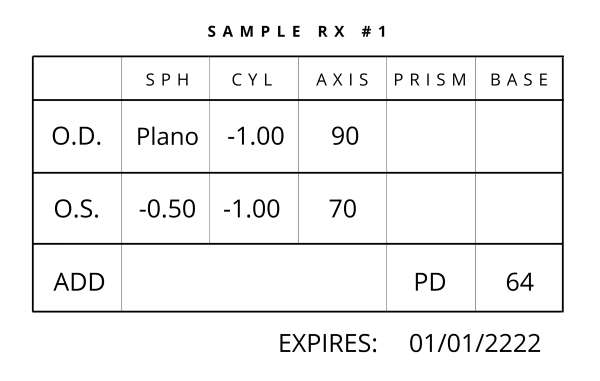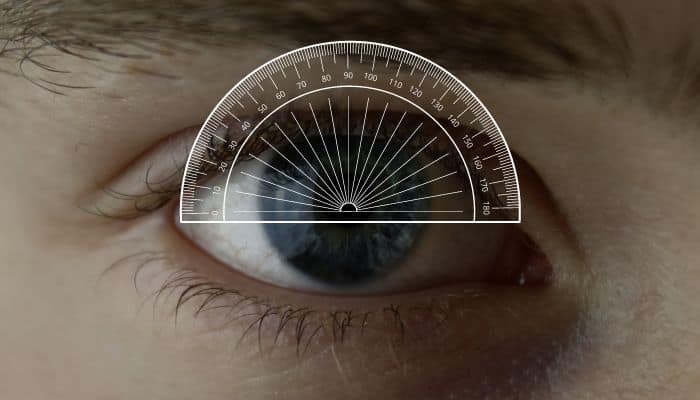Do you have an eyeglass prescription with a value in the axis column? If so, it indicates that you have astigmatism in your vision.
Astigmatism is a common eye condition that affects the way light is focused in the eye. It can cause blurred vision, especially when looking at objects that are not directly in front of you.
What Does Axis Mean on an Eyeglass Prescription?

In simple terms, ‘Axis’ is the angle at which the cylinder or CYL power in your lens works. It’s measured in degrees, anywhere from 1 to 180.
How Axis Helps Your Optician
The ‘Axis’ number tells your optician – the person who actually fills your prescription – the position of astigmatism, or where to put the cylindrical power in your glasses.
If the axis number is 180, the power is placed horizontally in the lens. If the axis number is 90, the power goes in vertically.

The Relationship Between Axis and Cylinder
On an eyeglass prescription, cylinder (CYL) and axis values always go hand in hand. If there’s no cylinder value on a prescription, there won’t be an axis value because there’s no astigmatism to correct.
Example Of A Glasses Prescription With Axis
In an eyeglass prescription, the axis is often written alongside the sphere (SPH) and cylinder (CYL) measurements. A prescription might look something like this:
| Eye | Sphere (SPH) | Cylinder (CYL) | Axis |
|---|---|---|---|
| OD (Right Eye) | -2.00 | -1.50 | x180 |
| OS (Left Eye) | -1.75 | -1.25 | x90 |
In this example:
- The first number for each eye (-2.00 for OD, -1.75 for OS) represents the sphere power (SPH) and is measured in diopters. It indicates the amount of lens power, measured in diopters, needed to correct nearsightedness or farsightedness.
- The second number for each eye (-1.50 for OD, -1.25 for OS) is the cylinder (CYL) value and also is measured in diopters. This number indicates the amount of lens power for astigmatism.
- The “x” followed by a number (180 for OD, 90 for OS) is the axis. It indicates the angle in degrees of the astigmatism correction on the lens, with values ranging from 1 to 180. In this example, the axis for the right eye is 180 degrees, which means the astigmatism is corrected along the horizontal meridian or plane. For the left eye, the axis is 90 degrees, meaning the astigmatism is corrected along the vertical position.
Why is Axis Important?

The axis is important because it determines how the cylinder power will correct astigmatism. Astigmatism is a condition in which the cornea, the clear front part of the eye, is not perfectly round.
This can cause blurred vision, especially when looking at objects that are not directly in front of you. The axis number tells the eye doctor how to correct the astigmatism so that you can see clearly.
Picking Glasses That Match Your Axis
The Impact of Axis on Lens Shape and Thickness

The ‘Axis’ on your prescription does more than just correct your vision – it also impacts the shape and thickness of your lenses.
If your cylinder power is high, your lenses will be thicker at the edges. The ‘Axis’ number tells you which part of the lens will be thicker or thinner.
For instance, if your axis is 180 degrees, your lenses will be thicker on the sides (the horizontal meridian) and thinner at the top and bottom (the vertical meridian).
If your axis is 90 degrees, the thickness switches – your lenses will be thicker at the top and bottom and thinner on the sides.
Choosing the Right Frames for Your Axis
When it comes to choosing frames, you need to think about how they’ll accommodate your lens shape and thickness.
Pick a Large Enough Frame

Your glasses should be large enough to hold your lenses without causing visual distortion or leaving gaps. Steer clear of frames with lenses that are too small or narrow.
Frames with lots of embellishments or details around the edges can also interfere with your lens fit.
Prioritize Frame Durability
The durability of your frames is another crucial factor. Your frames should be strong and sturdy, capable of bearing the weight of your lenses.
Frames made from robust materials such as titanium, flexon, or nylon are good choices.
For enhanced comfort, consider frames with spring hinges or adjustable nose pads.
Flatter Frames for High Astigmatism
Lastly, if you have high astigmatism, your choice of frame shape becomes particularly important.
Flatter frames are generally better as they can accommodate thicker lenses more easily and are less likely to distort your vision.